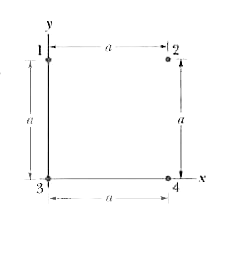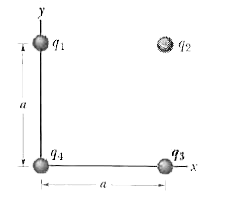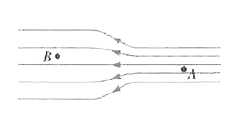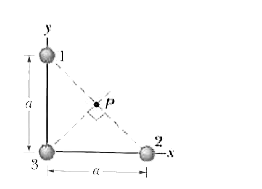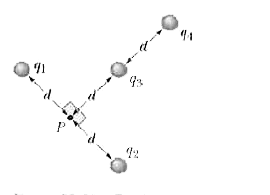Problems from RESNICK AND HALLIDAY PHYSICS Chapter 8 ELECTRIC CHARGES AND FIELDS for Class 12
| Class 12 | PHYSICS |
| Chapter | ELECTRIC CHARGES AND FIELDS |
| RESNICK AND HALLIDAY PHYSICS | Problems |
| Medium | English |
| Academic Year | 2023-2024 |
Question 3
In Fig., particle 1 of charge +6.0μC and particle 2 of charge −2.0μC are held at separation L=10.0cm on an x axis. If particle 3 of unknown charge q3 is to be located such that the net electrostatic force on it from particles 1 and 2 is zero, what must be the (a) x and (b) y coordinates of particle 3 ?
 View Solution
View SolutionQuestion 4
Three particles are fixed on an x axis. Particle 1 of charge q1 is at x = -a, and particle 2 charge q2 is at x = +a. If their net electrostatic force on particle 3 of charge +Q is to be zero, what must be the ratio q1/q2 when particle 3 is at (a) x = +0.750 a and (b) x = +1.50 a ?View SolutionQuestion 5
In Fig., particle 1 of charge +q and particle 2 of charge +9.00 q are held at separation L = 8.00 cm on an x axis. If particle 3 of charge q3 is to be located such that the three particles remain in place when released, what must be the (a) x and (b) y coordinates of particle 3, and (c ) the ratio q3/q ?
 View Solution
View SolutionQuestion 6
In Fig., particles 1 and 2 are fixed in place on an axis, at a separation of L = 6.00 cm. Their charges are q1=+e and q2=−27e. Particle 3 with charge q3=+4e is to be placed on the line between particles 1 and 2 , so that they produce a net electrostatic force →F3,net on it. (a) At what coordinate should particle 3 be placed to minimize the magnitude of that force ? (b) What is that minimum magnitude ?
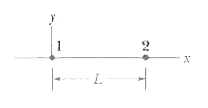 View Solution
View SolutionQuestion 8
Figure shows electrons 1 and 2 on an x axis and charged ions 3 and 4 of identical charge -q and at identical angles θ. Electron 2 is free to move, the other three particles are fixed in place at horizontal distances R from electron 2 and are intended to hold electron 2 in place. For physically possible values of q≤5e, what are the (a) largest, (b) second largest , and (c ) third largest values of θ for which electron 2 is held in place ?
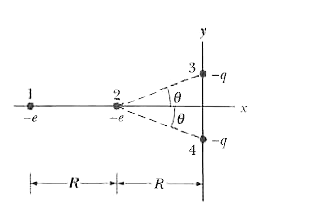 View Solution
View SolutionQuestion 9
The magnitude of the electrostatic force between point charges q1=26.0μC and q2=47.0μC is initially 5.70 N. The separation is the changed such that the force magnitude is then 0.570 N. (a) What is the ratio of the new separation to the initial separation ? (b) What is the new separation ?View SolutionQuestion 11
In Fig., particles 1 and 2 have charge 20.0μC each and are held at separation distance d = 0.75 m. (a) What is the magnitude of the electrostatic force on particle 1 due to particle 2? In Fig., particle 3 of charge 20.0μC is positioned so as to complete an equilateral triangle. (b) What is the magnitude of the net electrostatic force on particle 1 due to particles 2 and 3 ?
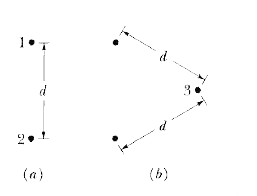 View Solution
View SolutionQuestion 13
The magnitude of the electrostatic force between two identical ions that separated by a distance of 10.0×10−10m is 9.25×10−10N. (a) What is the charge of each ion ? (b) How many electrons are "missing" from each ion (thus giving the ion its charge imbalance) ? (c ) What is the force magnitude if the separation is halved ?View SolutionQuestion 14
Two identical conducting spheres, fixed in place, attract each other with an electrostatic force of 0.108 N when their center-to-center separation is 50.0 cm. The spheres are then connected by a thin conducting wire. When the wire is removed, the spheres repel each other with an electrostatic force of 0.144 N. Of the initial charges on the spheres, with a positive net charge, what was (a) the negative charge on one of them and (b) the positive charge on the other ?View SolutionQuestion 15
Two equally charged particles, held 3.2×10−3m apart, are released from rest. The initial acceleration of the first particle is observed to be 7.0m/s2 and that of the second to be 9.0m/s2. If the mass of the first particle is 6.3×10−7kg, what are (a) the mass of the second particle and (b) the magnitude of the charge of each particle ? View SolutionQuestion 16
The charges and coordinates of two charged particles held fixed in an xy plane are q1=+3.0μC,x1=3.5cm,y1=0.50cm, and q2=−4.0μC,x2=−2.0cm,y2=1.5cm. Find the (a) magnitude and (b) direction of the electrostatic force on particle 1 due to particle 2. At what (c ) x and (d) y coordinates should a third particle of charge q3=+6.0μC be placed such that the net electrostatic force on particle 1 due to particles 2 and 3 is zero ?View SolutionQuestion 17
In Fig., particles 2 and 4, of charge -e are fixed in place on a y axis, at y2=−10.0cm and y4=5.00cm. Particles 1 and 3, of charge -e can be moved along the x axis. Particle 5, of charge +e, is fixed at the origin. Initially particle 1 is at x1=−10.0cm and particle 3 is at x3=10.0cm (a) To what x value must particle 1 be moved to rotate the direction of the net electric force →Fnet on particle 5 by 60∘ counterclockwise? (b) With particle 1 fixed at its new position, to what x value must you move particle 3 to rotate →Fnet back to its original direction ?
 View Solution
View SolutionQuestion 18
In crystals of the salt cesium, cesium ions Cs+ form the eight corners of a cube and a chlorine ion Cl− is at the cube's center Fig. The edge length of the cube is 0.40 nm. The Cs+ ions are each deficient by one electron (and thus each has a charge of -e), and the Cl− ion has one excess electron (and thus has a charge of -e). (a) What is the magnitude of the net electrostatic force exerted on the Cl− ion by the eight Cs+ ions at the corners of the cube? (b) If one of the Cs+ ions is missing, the crystal is said to have a defect, what is the magnitude of the net electrostatic force exerted on the Cl− ion by the seven remaining Cl+ ions ?
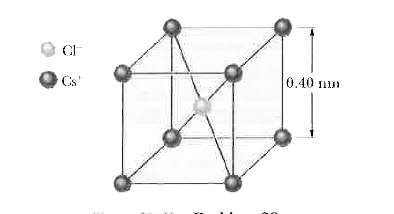 View Solution
View SolutionQuestion 19
Two particles are fixed on an x axis. Particle 1 of charge 50μC is located at x = - 20.0 cm, particle 2 of charge Q is located at x = 3.0 cm. Particle 3 of charge magnitude 20μC is released from rest on the y axis y = 2.0 cm. What is the value of Q if the initial acceleration of particle 3 is in the positive direction of (a) the x axis and (b) the y axis ?View SolutionQuestion 20
In Fig., particles 1 and 2 of charge q1=q2=+4e are on a y axis at distance d = 1.70 m from the origin. Particle 3 of charge q3=+8e is moved gradually along the x axis from x = 0 to x = +5.0 m. At what values of x will the magnitude of the electrostatic force on the third particle from the other two particles be (a) minimum and (b) maximum ? What are the (c ) minimum and (d) maximum magnitudes ?
 View Solution
View SolutionQuestion 21
In Fig. a, particle 1 (of charge q1) and particle 2 (of charge q2) are fixed in place on an x axis, 8.00 cm apart.
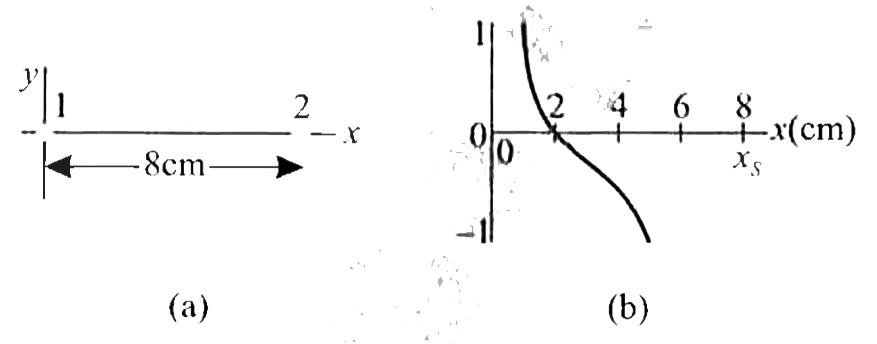
Particle 3 (of charge q3=+8.00×10−19C) is to be placed on the line between particles 1 and 2 so that they produce a net electrostatic force Fnet=2F0 on it Figure b gives the x component of that force versus the coordinate x at which particle 3 is placed. The scale of the x-axis is set by xs=8.0cm. What are (a) the sign of charge q1 and (b) the ratio q2/q1?View SolutionQuestion 23
Figure shows an arrangement of four charged particles, with angle θ=35.0∘ and distance d = 2.00 cm. Particle 2 has charge q2=+8.00×10−19C, particle 3 and 4 have charges q3=q4=−1.60×10−19C, (a) What is distance D between the origin and particle 2 if the net electrostatic force on particle 1 due to the other particles is zero ? (b) If particles 3 and 4 were moved closer to the x axis but maintained their symmetry about that axis, would the required value of D be greater than, less than, or the same as the part (a) ?
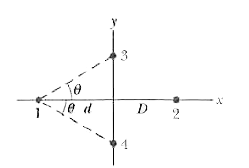 View Solution
View SolutionQuestion 25
Two charged particles are fixed to an x axis : Particle 1 of charge q1=2.1×10−8C is at position x = 20 cm and particle 2 of charge q2=−4.00q1 is at position x = 70 cm. (a) At what coordinate on the axis (other than at infinity) is the net electric field produced by the two particles equal to zero ? (b) What is the zero-field coordinate if the particles are interchanged ?View SolutionQuestion 27
Assume that a honeybee is a sphere of diameter 1.000 cm with a charge +60.0pC uniformly spread over its surface . Assume also that a spherical pollen grain of diameter 40.0μC is electrically held on the surface of the bee because the bee's charge induces a charge of 1.00pC on the near side of the grain and a charge of 1+1.00pC on the far side. (a) what is the magnitude of the net electrostatic force on the grain due to the bee ? Next, assume that the bee brings the grain to a distance of 1.000 mm from the tip of a flower's stigma and that the tip is a particle of charge −60.0pC. (b) What is magnitude of the net electrostatic force on the grain due to the stigma ? (c ) Does the grain remain on the bee or move to the stigma ?View SolutionQuestion 28
A thin nonconducting rod with a uniform distribution of positive charge Q is bent into a complete circle of radius R (Fig.). The central perpendicular axis through the ring is a z aaxis, with the origin at the center of the ring. What is the magnitude of the electric field due to the rod at (a) z = 0 and (b) z=∞ ? (c ) In terms of R, at what positive and Q=5.00μC, what is the maximum magnitude ?
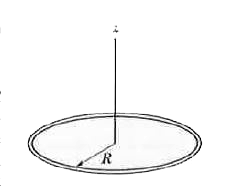 View Solution
View SolutionQuestion 29
Two large parallel copper plates are 8.0 cm apart and have a uniform electric field between them as depicted in Fig. An electron is released from the negatibe plate at the same time that a proton is released from the positive plate. Neglect the force of the particle on each other and find their distance from the positive plate when they pass each other.
 View Solution
View SolutionQuestion 30
Figure shows an uneven arrangement of electrons (e) and protons (p) on a circular arc of radius r = 2.50 cm, with angles θ1=30.0∘,θ2=50.0∘,θ3=30.0∘, and θ4=20.0∘. What are the (a) magnitude and (b) direction (relative to the positive direction of the x axis) of the net electric field produced at the net electric field produced at the center of the arc ?
 View Solution
View SolutionQuestion 31
In Fig., positive charge q = 9.25 pC is spread uniformly along a thin nonconducting rod of length L = 16.0 cm. What are the (a) magnitude and (b) direction (relative to the positive direction of the x axis) of the electric field produced at point P, at distance R = 6.00 cm from the rod along its perpendicular bisector ?
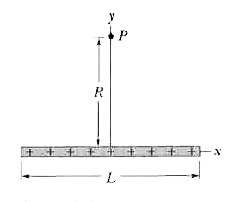 View Solution
View SolutionQuestion 32
In Fig., two curved plastic rods, one of charge +q and the other of charge -q form a circle of radius R = 4.25 cm in an xy plane. The x axis passes through both of the connecting points and the charge is distributed uniformly on both rods. If q = 15.0 pC, what are the (a) magnitude and (b) direction (relative to the positive direction of the x axis) of the electric field →E produced at P, the center of the circle ?
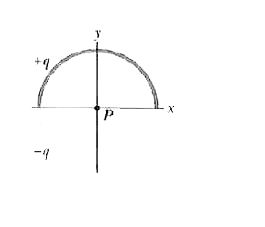 View Solution
View SolutionQuestion 34
In Fig., a nonconducting rod of length L = 8.15 cm has a charge -q = -4.23 fC uniformly distributed along its length. (a) What is the linear charge density of the rod ? What are the (b) magnitude and (c ) direction (relative to the positive direction of the x axis) of the electric field produced at point P, at distance a = 6.00 cm from the rod ? What is the electric field magnitude produced at distance a = 50 m by (d) the rod and (e) a particle of charge -q = -4.23 fC that we use to replace the rod ? (At that distance, the rod "looks" like a particle.)
 View Solution
View SolutionQuestion 35
In Fig., a thin rod forms a semicircle of radius r = 3.00 cm. Charge is uniformly distributed along the rod, with +q = 4.50 pC in the upper half and -q = -4.50 pC in the lower half. What are the (a) magnitude and (b) direction (relative to the positive direction of the x axis) of the electric field →E at P, the center of the semicircle ?
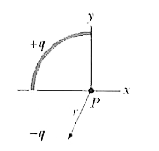 View Solution
View SolutionQuestion 38
An electron with a speed of 2.60×108cm/s enters and electric field of magnitude 1.00×103N/C, travelling along a field in the direction that retards its motion. (a) How far will the electron travel in the field before stopping momentarily, and (b) how much time will have elapsed ? (c ) If the region containing the electric field is 8.00 mm long (too short for the electroc to stop within it),what fraction of the electrons initial energy will be lost in that region ?View SolutionQuestion 39
An electron is released from rest on the axis of an electric dipole is 25 nm from the center of the dipole. What is the magnitude of the electron's acceleration if the dipole moment is 3.6×10−29C.m? Assume that 25 nm is much larger than the separation of the charged particles that form the dipole ?View SolutionQuestion 41
Figure shows a distance ring of radius R = 43.0 cm. Two small charged beads are on the ring : Bead 1 of charge +20.0μC is fixed in place at the left side , bead 2 of charge +6.00μC can be moved along the ring. The two beads produce a net electric field of magnitude e at the center of the ring. At what (a) positive and (b) negative value of angle θ should bead 2 be positioned such that E=2.00×105N/C ?
 View Solution
View SolutionQuestion 42
Figure shows two concentric rings, of radii R and R' = 4.00 R, that lie on the same plane. Point P lies on the central z axis, at distance D = 2.00 R from the center of the rings. The smaller ring has uniformly distributed charge +Q. In terms of Q, what is the uniformly distributed charge on the larger ring if the net electriv field at P is zero ?
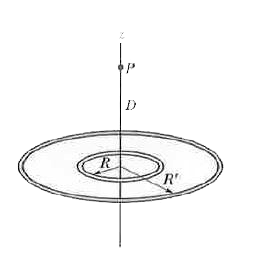 View Solution
View SolutionQuestion 43
A circular plastic disk with radius R = 2.00 cm has a uniformly distributed charge Q=+(2.00×106)e on one face. A circular ring of width 40μm is centers on that face, with the center of that width at radius r = 0.50 cm. In coulombs, what charge is contained within the width of the ring ?View SolutionQuestion 47
An electric dipole consisting of charges of magnitude 1.50nC separated by 6.20 μm is in an electric field of strength 300 N/C. what are (a) the magnitude of the electric dipole moment and (b) the difference between the potential energies for dipole orientations parallel and perpendicular to →E ?View SolutionQuestion 49
An electron enters a region of uniform electric field with an initial velocity of 30 km/s in the same direction as the electric field, which has magnitude E = 50 N/C. (a) What is the speed of the electron 1.5 ns after entering this region? (b) How far does the electron travel during the 1.5 ns interval ?View SolutionQuestion 50
A uniform electric field exists in a region between two oppositely charged plates. An electron is released from rest at the surface of the negatively charged plate and strikes the surface of the opposite plate, 3.0 cm away, in a time 1.5×10−8s. Just as the electron strikes the second plate, what are the its (a) momentum magnitude and (b) kinetic energy ? (c ) What is the magnitude of the electric field →E ?View SolutionQuestion 51
An electric dipole consists of charges +2eand−2e separated by 0.78mm. It is an electric field of strength 3.4×106N/C. Calculate the magnitude of the torque on the dipole when the dipole moment is (a) parallel to (b) perpendicular to, and (c) anti-parallel to the electric field.View SolutionQuestion 52
At some instant the velocity components of an electron moving between two charged parallel plates are vx=1.5×105m/s and vy=3.0×106m/s.Suppose that the electric field between the plates is given by E=(120N/C)ˆj
. (a) What is the acceleration of the electron?
(b) What will be the velocity of the electron after its x-coordinate has changed by 2.0 cm? View SolutionQuestion 54
In Fig. a "semi-infinite" nonconducting rod (that is, infinite in one direction only) has uniform linear charge density λ. (a) show that the electric field →Epat point P makes an angle 45∘ with the rod and that this result is independent of the distance R. (Hint : Separetly find the component of →Ep parallel to the rod and the component perpendicular to the rod.) (b) Find the the field magnitude for linear charge density 4.52 nC/m and R = 3.80 cm.
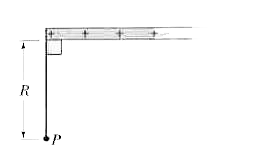 View Solution
View SolutionQuestion 55
Figure shows two charged particles on an x axis : −q=−3.20×10−19C at x=−3.00m and q=3.20×10−19C at = + 3.00 m. What are (a) magnitude and (b) direction (relative to the positive direction of the x axis) of the net electric field produced at point P at y = 4.00 m? (c ) What is the magnitude of the net field if y is doubled ?
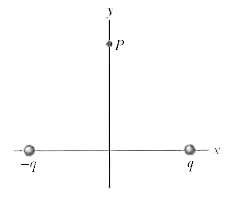 View Solution
View SolutionQuestion 56
In Fig. an electron (e) is to be released from rest on the central axis of a uniformly charged disk of radius R. The surface charge density on the disk is +5.00μC/m2. What is the magnitude of the electron's initial acceleration if it is released at a distance (a) R, (b) R/100, and (c ) R/1000 from the center of the disk ? (d) Why does the acceleration magnitude increase only slightly as the release point is moved closer to the disk ?
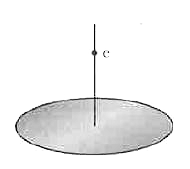 View Solution
View SolutionQuestion 57
Figure shows the three circular arcs centered on the origin of a coordinate system. On each arc, the uniformly distributed charge is given in terms of Q=4.00μC. The radii are given in terms of R = 5.00 cm. What are the (a) magnitude and (b) direction (relative to the positive x direction) of the net electric field at origin due to the arc ?
 View Solution
View SolutionQuestion 60
A semi-infinite charged rod is arranged so that its one end coincides with the center of a charged ring as shown in Fig. Both of them have a charge per unit length of λ. The radius of ring is R. The electric field of rof exert force on an element of the ring as shown in Fig. (a) What is the force on the ring due to the rod ? (b) What is the increase in the tension of the ring due to the rod ?
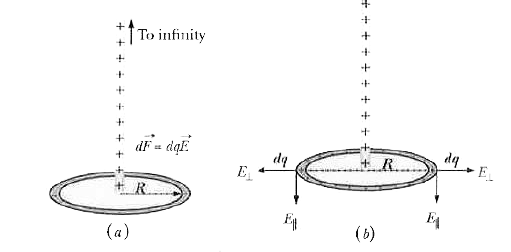 View Solution
View SolutionQuestion 62
A conducting spherical shell of outer radius R and inner radius r = 3R/4 has no net charge on it. At its center there is a point charge q, and at a distance 2R from its center there is a point charge Q (Fig.) . (a) What is the magnitude of the electrostatic force on the charge q at the center due to the shell ? (b) What is the magnitude of net force on it?
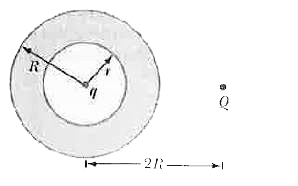 View Solution
View SolutionQuestion 63
A pellet with charge +Q is centered inside a spherical cavity in a conducting ball. The conducting ball has a charge -2q on it. The cavity in the ball is off-center, as shown in Fig. (a) How much charge resides on the inner surface of the cavity ? (b) Is the charge on the cavity surface distributed uniformly or nonuniformly ? Why ? (c ) How much charge resides on the outer surface of the conducting ball ? (d) Is the charge on the ball's outer surface distribution uniformly or nonuniformly ?
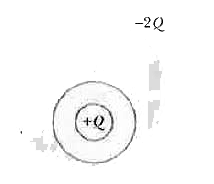 View Solution
View Solution


